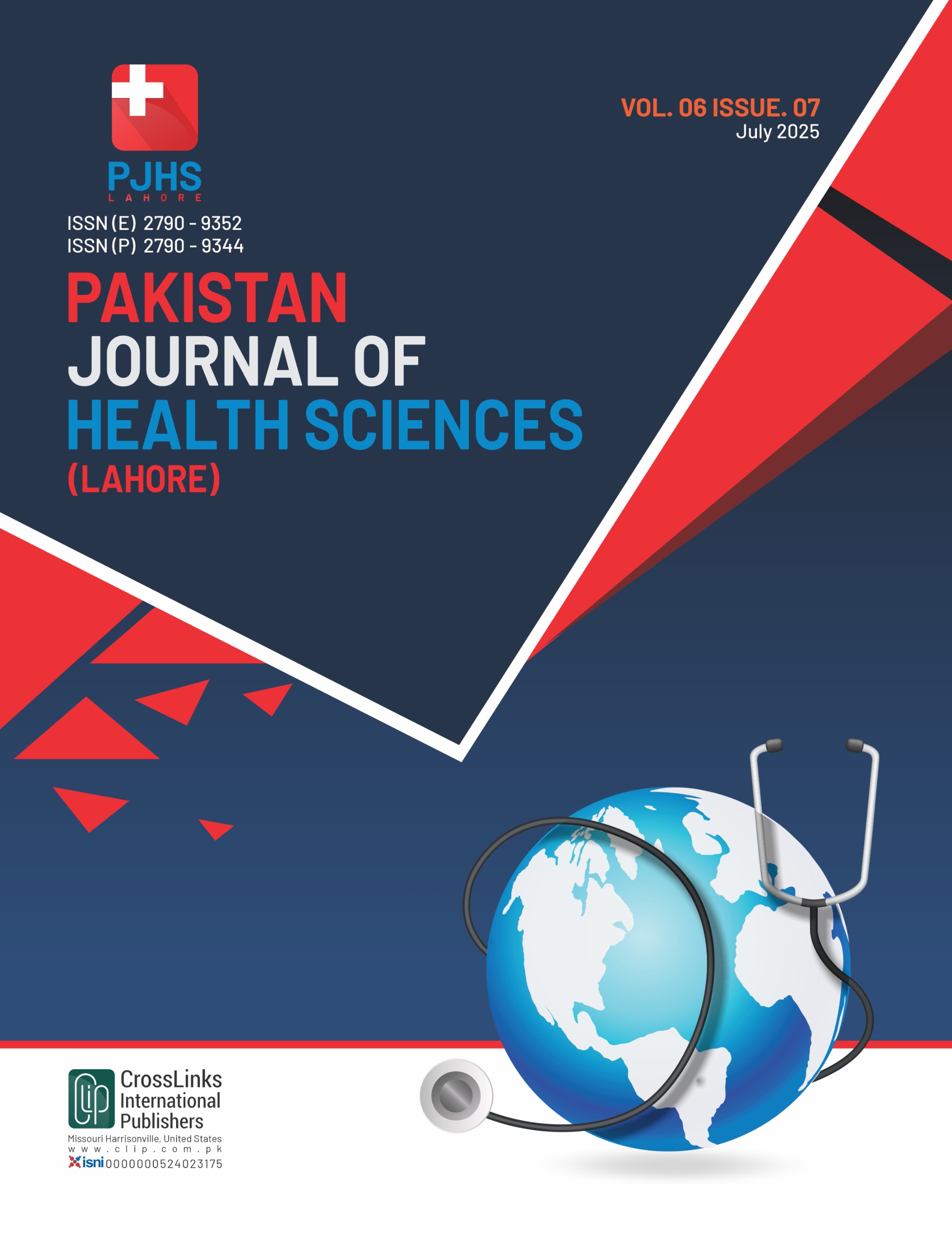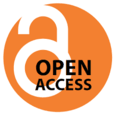Effects of Home Blood Sugar Monitoring on HbA1c Among Diabetes Mellitus Patients Attending a Tertiary Care Hospital in Peshawar
Effects of Home Blood Sugar Monitoring on HbA1c Levels
DOI:
https://doi.org/10.54393/pjhs.v6i7.3219Keywords:
HbA1c Level, Monitoring, Blood Glucose, Type II Diabetes MellitusAbstract
Diabetes mellitus (DM), encompassing both type 1 and type 2, has escalated worldwide over the last twenty years, resulting in elevated death and morbidity rates. Prior research indicates that home blood glucose monitoring enhances metabolic control and aids in alleviating the atherosclerotic effects of type 2 diabetes mellitus. Objectives: To evaluate the effect of home blood glucose monitoring on HbA1c levels among diabetic patients at Lady Reading Hospital (LRH), Peshawar. Methods: This quasi-experimental study was performed over six months in the Department of General Medicine at LRH, Peshawar, including 62 diabetic patients. Participants were directed to assess fasting blood glucose thrice weekly for three months, maintaining their existing medical care. HbA1c was measured before and during the intervention. Means and standard deviations were used to evaluate continuous variables in SPSS version 22.0. A paired t-test was used to compare pre- and post-intervention mean HbA1c levels, with p < 0.05 indicating statistical significance. Results: The mean age of participants was 45 ± 12.29 years, with 61% male and 39% female. The average diabetes duration was 10 ± 5.8 years. Pre-monitoring HbA1c was 9.62 ± 1.87%, which significantly reduced to 8.02 ± 1.19% after three months (mean difference=1.6%, p=0.0001). Significant reductions were observed across all age groups, genders, weight categories, and diabetes durations (p<0.05). Conclusions: Home blood glucose monitoring significantly improves glycemic control in diabetic patients, as evidenced by the reduction in HbA1c levels, consistent across various demographics.
References
Evans M, Welsh Z, Ells S, Seibold A. The Impact of Flash Glucose Monitoring on Glycaemic Control as Measured by HbA1c: A Meta-Analysis of Clinical Trials and Real-World Observational Studies. Diabetes Therapy. 2020 Jan; 11(1): 83–95. doi: 10.1007/s13300-019-00720-0. DOI: https://doi.org/10.1007/s13300-019-00720-0
American Diabetes Association. Glycemic Targets: Standards of Medical Care in Diabetes-2021. Diabetes Care. 2021 Jan; 44(Suppl 1): S73–84. doi: 10.2337/dc21-S006. DOI: https://doi.org/10.2337/dc21-S006
Mukhopadhyay B. Diabetes Control and Outcomes (DCCT)-1993. In: Top Articles in Primary Care. Cham: Springer International Publishing. 2023 May; 75–78. doi: 10.1007/978-3-031-25620-2_17. DOI: https://doi.org/10.1007/978-3-031-25620-2_17
Lachin JM and Nathan DM. Understanding Metabolic Memory: The Prolonged Influence of Glycemia During the Diabetes Control and Complications Trial (DCCT) on Future Risks of Complications During the Study of the Epidemiology of Diabetes Interventions and Complications (EDIC). Diabetes Care. 2021 Oct; 44(10): 2216–24. doi: 10.2337/dc20-3097. DOI: https://doi.org/10.2337/dc20-3097
Harashima SI, Nishimura A, Ikeda K, Wang Y, Liu Y, Inagaki N. Once Daily Self-Monitoring of Blood Glucose (SMBG) Improves Glycemic Control in Oral Hypoglycemic Agents (OHA)-Treated Diabetes: SMBG-OHA Follow-Up Study. Journal of Diabetes Science and Technology. 2016 Mar; 10(2): 378–82. doi: 10.1177/1932296815608869. DOI: https://doi.org/10.1177/1932296815608869
Prahalad P, Ding VY, Zaharieva DP, Addala A, Johari R, Scheinker D, et al. Teamwork, Targets, Technology, and Tight Control in Newly Diagnosed Type 1 Diabetes: The Pilot 4T Study. The Journal of Clinical Endocrinology and Metabolism. 2022 Apr; 107(4): 998–1008. doi: 10.1210/clinem/dgab859. DOI: https://doi.org/10.1210/clinem/dgab859
Bomholt T, Adrian T, Nørgaard K, Ranjan AG, Almdal T, Larsson A, et al. The Use of HbA1c, Glycated Albumin and Continuous Glucose Monitoring to Assess Glucose Control in the Chronic Kidney Disease Population Including Dialysis. Nephron. 2021 Dec; 145(1): 14–9. doi: 10.1159/000511614. DOI: https://doi.org/10.1159/000511614
Aslam R, Suhail S, Sajid R, bin Younis B. Type 2 Diabetes Mellitus (T2DM) in Pakistan: Prevalence, Trends and Management Strategies. Annals of King Edward Medical University. 2022 Aug; 28(2): 247–54. doi: 10.21649/akemu.v28i2.5117. DOI: https://doi.org/10.21649/akemu.v28i2.5117
Carlson AL, Criego AB, Martens TW, Bergenstal RM. HbA1c: The Glucose Management Indicator, Time in Range, and Standardization of Continuous Glucose Monitoring Reports in Clinical Practice. Endocrinology and Metabolism Clinics. 2020 Mar; 49(1): 95–107. doi: 10.1016/j.ecl.2019.10.010. DOI: https://doi.org/10.1016/j.ecl.2019.10.010
Khan T, Khan H, Khan RM, Khan W, Khan N. Average HbA1c in Diabetic Patients in Southern KPK-Pakistan. Journal of Women Medical and Dental College. 2022 Sep; 1(2). doi: 10.56600/jwmdc.v1i2.20. DOI: https://doi.org/10.56600/jwmdc.v1i2.20
Siddique K, Malik RA, Usman A, Ishfaq K, Nadeem MS, Qadir M, et al. Self-Care Behaviors and Glycemic Control Among Older Type 2 Diabetes Mellitus Patients in Low-Income Families in Southern Punjab, Pakistan. Journal of Human Behavior in the Social Environment. 2022 Jan; 32(1): 67–76. doi: 10.1080/10911359.2020.1851843. DOI: https://doi.org/10.1080/10911359.2020.1851843
Wada E, Onoue T, Kobayashi T, Handa T, Hayase A, Ito M, et al. Flash Glucose Monitoring Helps Achieve Better Glycemic Control than Conventional Self-Monitoring of Blood Glucose in Non-Insulin-Treated Type 2 Diabetes: A Randomized Controlled Trial. BMJ Open Diabetes Research and Care. 2020 Jun; 8(1). doi: 10.1136/bmjdrc-2019-001115. DOI: https://doi.org/10.1136/bmjdrc-2019-001115
Sia HK, Kor CT, Tu ST, Liao PY, Wang JY. Self-Monitoring of Blood Glucose in Association with Glycemic Control in Newly Diagnosed Non-Insulin-Treated Diabetes Patients: A Retrospective Cohort Study. Scientific Reports. 2021 Jan; 11(1): 1176. doi: 10.1038/s41598-021-81024-x. DOI: https://doi.org/10.1038/s41598-021-81024-x
Lai M, Weng J, Yang J, Gong Y, Fang F, Li N, et al. Effect of Continuous Glucose Monitoring Compared with Self-Monitoring of Blood Glucose in Gestational Diabetes Patients with HbA1c < 6%: A Randomized Controlled Trial. Frontiers in Endocrinology. 2023 Apr; 14: 1174239. doi: 10.3389/fendo.2023.1174239. DOI: https://doi.org/10.3389/fendo.2023.1174239
Rochmah N, Soetjipto S, Faizi M, Hisbiyah Y, Perwitasari RK, Fedora K, et al. Frequent Self-Monitoring Blood Glucose Correlated to Better Medication Adherence and Glycemic Control in Children with Type 1 Diabetes Mellitus. Diabetes, Metabolic Syndrome and Obesity. 2024 Dec; 2203–9. doi: 10.2147/DMSO.S448508. DOI: https://doi.org/10.2147/DMSO.S448508
Raja C, Ramachandran M, Nanjundan P, Rajamanickam J. Industrial Engineering Using IBM SPSS Statistics. Journal on Electronic and Automation Engineering. 2023 Sep; 2: 3. doi: 10.46632/jeae/2/3/4. DOI: https://doi.org/10.46632/jeae/2/3/4
Kim H, Lee SH, Cho JH, Yim HW, Kim HS. Long-Term Changes in HbA1c According to Blood Glucose Control Status During the First 3 Months After Visiting a Tertiary University Hospital. Journal of Korean Medical Science. 2022 Sep; 37(38). doi: 10.3346/jkms.2022.37.e281. DOI: https://doi.org/10.3346/jkms.2022.37.e281
Moradi G, Shokri A, Mohamadi-Bolbanabad A, Zareie B, Piroozi B. Evaluating the Quality of Care for Patients with Type 2 Diabetes Mellitus Based on the HbA1c: A National Survey in Iran. Heliyon. 2021 Mar; 7(3). doi: 10.1016/j.heliyon.2021.e06485. DOI: https://doi.org/10.1016/j.heliyon.2021.e06485
Moshoeshoe BS, Bayat Z, Bulbulia S. Relationship Between Diabetes Knowledge, Self-Management Practices, and Glycaemic Control Among Patients Attending Diabetic Clinic at a Tertiary Level Hospital in Johannesburg, South Africa. Journal of Endocrinology, Metabolism and Diabetes in South Africa. 2025 Apr; 30(1): 1–7. doi: 10.1080/16089677.2024.2430118. DOI: https://doi.org/10.1080/16089677.2024.2430118
Chrzanowski J, Michalak A, Łosiewicz A, Kuśmierczyk H, Mianowska B, Szadkowska A, et al. Improved Estimation of Glycated Hemoglobin from Continuous Glucose Monitoring and Past Glycated Hemoglobin Data. Diabetes Technology and Therapeutics. 2021 Apr; 23(4): 293–305. doi: 10.1089/dia.2020.0433. DOI: https://doi.org/10.1089/dia.2020.0433
Xu R, Xing M, Javaherian K, Peters R, Ross W, Bernal-Mizrachi C. Improving HbA1c with Glucose Self-Monitoring in Diabetic Patients with EpxDiabetes, a Phone Call and Text Message-Based Telemedicine Platform: A Randomized Controlled Trial. Telemedicine and e-Health. 2020 Jun; 26(6): 784–93. doi: 10.1089/tmj.2019.0035. DOI: https://doi.org/10.1089/tmj.2019.0035
Tonaco LA, Velasquez-Melendez G, Moreira AD, Andrade FC, Malta DC, Felisbino-Mendes MS. Awareness of the Diagnosis, Treatment, and Control of Diabetes Mellitus in Brazil. Revista de Saude Publica. 2023 Nov; 57: 75. doi: 10.11606/s1518-8787.2023057005167. DOI: https://doi.org/10.11606/s1518-8787.2023057005167
Bent B, Cho PJ, Wittmann A, Thacker C, Muppidi S, Snyder M, et al. Non-Invasive Wearables for Remote Monitoring of HbA1c and Glucose Variability: Proof of Concept. BMJ Open Diabetes Research and Care. 2021 Jun; 9(1). doi: 10.1136/bmjdrc-2020-002027. DOI: https://doi.org/10.1136/bmjdrc-2020-002027
Fabris C, Heinemann L, Beck R, Cobelli C, Kovatchev B. Estimation of Hemoglobin A1c from Continuous Glucose Monitoring Data in Individuals with Type 1 Diabetes: Is Time in Range All We Need? Diabetes Technology and Therapeutics. 2020 Jul; 22(7): 501–8. doi: 10.1089/dia.2020.0236. DOI: https://doi.org/10.1089/dia.2020.0236
Tanenbaum ML, Zaharieva DP, Addala A, Prahalad P, Hooper JA, Leverenz B, et al. 'Much More Convenient, Just as Effective': Experiences of Starting Continuous Glucose Monitoring Remotely Following Type 1 Diabetes Diagnosis. Diabetic Medicine. 2022 Nov; 39(11): e14923. doi: 10.1111/dme.14923. DOI: https://doi.org/10.1111/dme.14923
Styles S, Wheeler B, Boucsein A, Crocket H, de Lange M, Signal D, et al. A Comparison of FreeStyle Libre 2 to Self-Monitoring of Blood Glucose in Children with Type 1 Diabetes and Sub-Optimal Glycaemic Control: A 12-Week Randomised Controlled Trial Protocol. Journal of Diabetes and Metabolic Disorders. 2021 Dec; 20(2): 2093–101. doi: 10.1007/s40200-021-00907-y. DOI: https://doi.org/10.1007/s40200-021-00907-y
Klupa T, Czupryniak L, Dzida G, Fichna P, Jarosz-Chobot P, Gumprecht J, et al. Expanding the Role of Continuous Glucose Monitoring in Modern Diabetes Care Beyond Type 1 Disease. Diabetes Therapy. 2023 Aug; 14(8): 1241–66. doi: 10.1007/s13300-023-01431-3. DOI: https://doi.org/10.1007/s13300-023-01431-3
Downloads
Published
How to Cite
Issue
Section
License
Copyright (c) 2025 Pakistan Journal of Health Sciences

This work is licensed under a Creative Commons Attribution 4.0 International License.
This is an open-access journal and all the published articles / items are distributed under the terms of the Creative Commons Attribution License, which permits unrestricted use, distribution, and reproduction in any medium, provided the original author and source are credited. For comments













